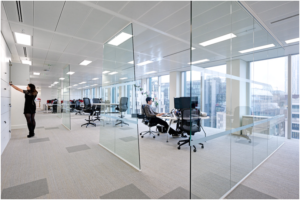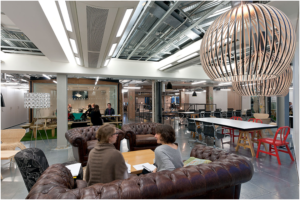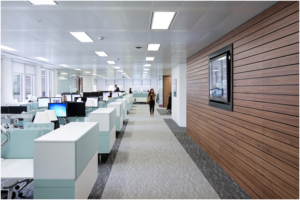Never has the impact of office design on a company’s functionally been so heavily examined as it is today. In increasing quantities, businesses are employing the assistance of professional service companies to optimise their office design for improved productivity levels, higher staff morale, and more defined company branding, among other advantages. Companies in two industries in particular stand to benefit from such investment: marketing and finance. We illustrate case studies from the work of a leading office consultancy to reflect on the distinctions in office design between marketing and finance companies.

Office Design for Finance Companies
The offices of Natixis Global – an asset management firm – are a good place to start. Having recently engaged design and relocation experts, Interactive Space, to oversee the design and management of the company’s first UK office, Natixis were keen to create a bold design statement through their workplace. Interactive Space achieved a workspace aesthetic that is focused on conveying a modern, forward-thinking finance company. From entering the reception area to walking through the designated work areas, from rooms fit for board meetings to breakout areas for colleague brainstorming, the overall tone seamlessly blended the corporate setting with a tone of contemporaneity. Soothing colours were employed to create an inviting feel, with the brand’s chosen shade of purple visible in the reception area – an unmissable contrast against the clean white walls. In the staff room, bold monochrome purple tiles are complemented by unusual lighting and comfortable seating to offer a relaxing breakout room. The accomplished design is a testament to the changing face of perceived professionalism: corporate is no longer bland and authoritative no longer lacks character.

Over at financial consultancy Accuracy, Interactive Space assisted in conjuring up a dynamic environment. Much thought was given as to which types of elements would deliver the greatest impact, with the final outcome including a dominant formal workroom, a large café-style break-out space for staff, and a series of informal workspaces. Interestingly, an emphasis was placed on the ‘wow’ factor: a tour of the new space reveals an extensive use of bright colours and unique wall textures, as well as a classic Smeg fridge that is adorned with the Union flag. Quirky, chic and unique. Is this the new face of finance?
Office Design for Marketing Companies
And what of working life on the flipside? Over at Dentsu, a London-based advertising agency, Interactive Space was tasked with evoking Dentsu’s mission statement: “making future magic.” And they certainly delivered! The inside of the building is wholly in keeping with the building’s futuristic, aluminium-clad façade, with the reception area somewhat reminiscent of a spaceship; white curved walls and striking green floors complete the space. Standalone white and wooden pods offer secluded areas for meetings and brainstorming, while – as is to be expected – colour reigns supreme throughout.

Likewise, at EDC Communications – a provider of speaker skills training – quirky is key. The company employed Interactive Space to develop a ‘radical shabby-chic scheme,’ and the result is phenomenal and beautifully individual. The overall look and feel are akin to sitting in the woods; Interactive Space opted for faux grass flooring in meeting areas, with bespoke wooden tables and chairs. This rustic aesthetic contrasts with exposed pipework, artfully ‘unfinished’ plaster work on pillars, and football tables peppered about the place. More importantly, it’s certainly one that clients won’t forget. It demonstrates that the offices of marketing companies still channel a sense of creativity to support their brand’s ethos.
The Outcome?
Today, while embracing the propensity to incorporate colour and fluid ways of working into their workplace strategy, companies in the finance industry seem to remain partial to a conservative look and a sense of formality. Marketing agencies have opened the floodgates of creativity, and constantly seek for ways to innovate their offices and share their dynamism. Nevertheless, the two roads seem to be verging together: financial firms are becoming more expressive and marketing agencies are seeking for ways to enhance their professionalism. Who knows what the future of office design may bring?

